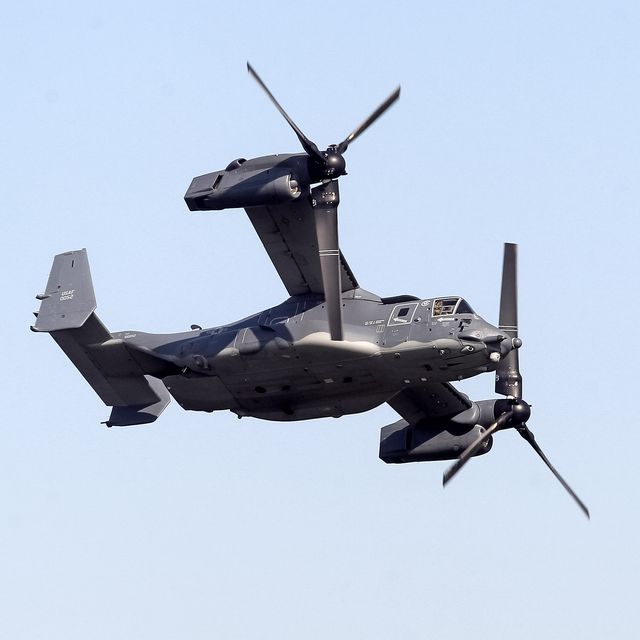- The U.S. Air Force is grounding its fleet of Osprey tiltrotor aircraft due to a new safety issue.
- Ospreys on training flights have experienced slipping clutches, resulting in emergency landings.
- The Marine Corps, on the other hand, will not ground its own fleet of Ospreys.
The U.S. Air Force grounded all 52 of its CV-22 Osprey tiltrotor aircraft this week, pending an investigation into a mysterious mechanical issue afflicting the fleet’s engine clutches. Although none of the incidents have resulted in injuries or loss of aircraft, the service is standing down. For the U.S. Marines Corps, on the other hand, which operates an even larger fleet of Ospreys, it’s still business as usual.
✅ Don’t miss any of our best-in-class military and defense news. Join our squad with Pop Mech Pro.
In an exclusive published on Wednesday, Breaking Defense reports that two incidents in the last six weeks, and a total of four since 2017, have involved a slipping clutch providing power to the Osprey’s Rolls-Royce Liberty AE1107C engines. When the clutch slips, the tiltrotor instantly transfers power to the other engine, per the aircraft’s built-in safety features. The clutch usually re-engages, restoring normal power to the aircraft, but the problem is jarring when it happens, and the Air Force worries it could result in the aircrew losing control of the aircraft.
The Air Force crews immediately landed their planes after each incident, and the service stresses no aircraft or crews have been lost due to the issue. Air Force Ospreys belong to Air Force Special Operations Command, a component of U.S. Special Operations Command. The aircraft are used as a long-range transport and resupply platform for special operations troops.
The V-22 Osprey—known as the CV-22 in Air Force service, MV-22B Osprey in Marine Corps service, and CV-22B in Navy service—is the world’s first operational tiltrotor aircraft. The Osprey can tilt the two nacelles on its wingtips 90 degrees, positioning its propellers vertically or horizontally (forward) depending on the situation. In the vertical configuration, the Osprey can take off and land like a conventional helicopter. Rotating the nacelles to a horizontal configuration allows the Osprey to fly like a conventional prop-driven aircraft. The Osprey also has a greater range than most helicopters.
As the first of its kind, the Osprey faced considerable controversy early in its career. First unveiled in 1988, the aircraft was involved in at least two fatal crashes and several accidents both in the air and on the ground. However, those issues were ironed out in time and the Air Force, and then the Navy, moved to adopt the aircraft in the 2000s and 2010s.
The Marines have flown the Osprey since 2007, using it as an assault transport. But notably, it has declined to ground its fleet of approximately 360 MV-22 Ospreys. The service says it has known about the issue since 2010 and told Breaking Defense, “we have trained our pilots to react with the appropriate emergency control measures should the issue arise during flight.” Of the 15 known incidents, ten have occurred to Marine Corps Ospreys.

Kyle Mizokami is a writer on defense and security issues and has been at Popular Mechanics since 2015. If it involves explosions or projectiles, he's generally in favor of it. Kyle’s articles have appeared at The Daily Beast, U.S. Naval Institute News, The Diplomat, Foreign Policy, Combat Aircraft Monthly, VICE News, and others. He lives in San Francisco.















